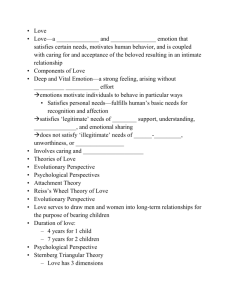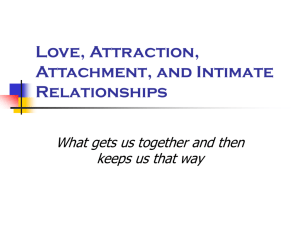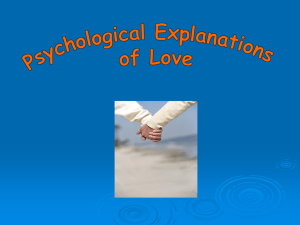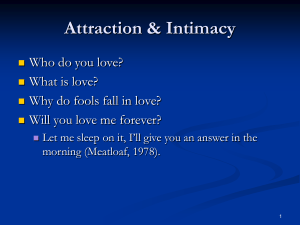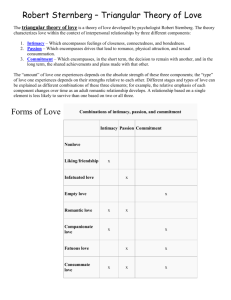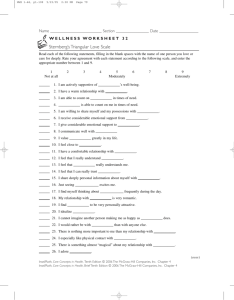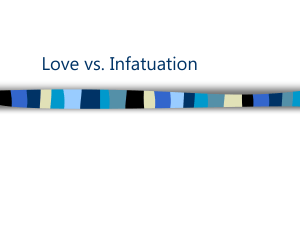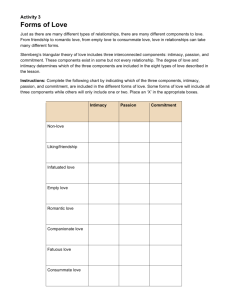Love, Attraction, Attachment, and Intimate Relationships
advertisement
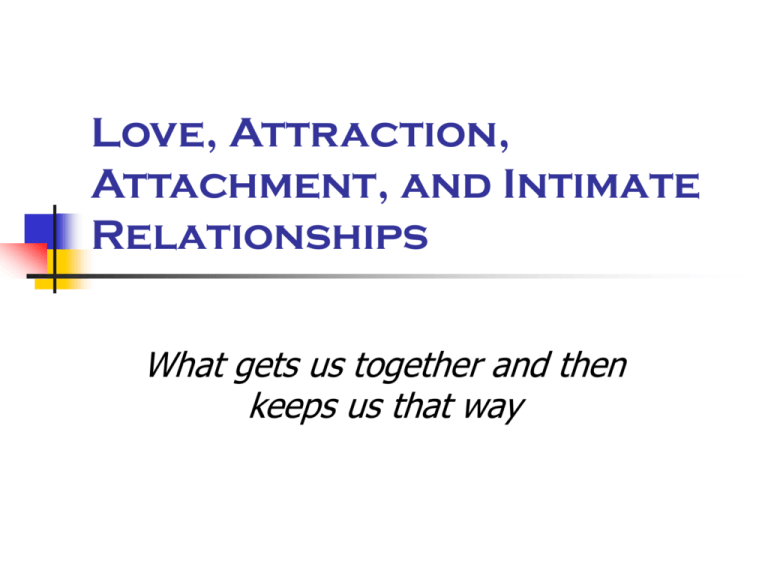
Love, Attraction, Attachment, and Intimate Relationships What gets us together and then keeps us that way Love What exactly is it ? An attitude ? A phenomenon ? Hard to define – can it be measured ? The Love Scale Rubin tried by having hundreds of couples respond to a questionnaire. The Love Scale had three components: Attachment – the desire for another’s presence and emotional support Caring – concern for the other’s well being Intimacy – desire for close, confidential communication Is the Love Scale meaningful ? Maybe, couples who scored high spend more time looking in each others eyes Types of Love Passionate A state of extreme absorption with and desire for another Intense feelings – sexual desire, then vacillating from anxiety to ecstasy wide-spread physiological arousal Ignorance is bliss Passion’s Rapid Course Typically hits fast Logic is pushed aside Can lead to premature commitments Or, the big fade Companionate Love Based on friendly affection and deep attachment due to extensive familiarity Less intense Knowing and forgiving Willing to work Endures after passion evaporates Sex is rich, mature, communicative, willing to take risks While occasionally passionate love can reemerge as companionate love, sometimes the reverse happens and old friends or co-workers can see their affections ignite sexually Sternberg’s Triangular Theory Love’s Three Faces Passion Fuels romantic feelings and desire for sexual interaction and unification Similar to an addiction, intensity causes a powerful craving More Sternberg Intimacy The emotional component A sense of bonding Warmth, sharing, emotional closeness Willing to help and share private essence The Triangle’s Third Side Commitment The cognitive aspect A conscious decision to love another The choice to maintain a relationship despite challenges That’s How It Works ! Putting it all together Sternberg explains the transition from passionate to companionate love Passionate love develops rapidly and intensely, then declines. Intimacy and commitment grow. If they don’t, the drop in passion likely signals the relationship’s end. Taking It Apart The interplay of these three components and their varying power over time results in differences in how we experience love. Isolating and combining the three faces gives us informative labels for differing types of love. Labels Infatuation – just passion Empty (love) – commitment only Companionate – intimacy & commitment Romantic – passion & intimacy Consummate – love that has it all Support for the Triangle ? Research shows that: 1) the presence of intimacy and commitment predict stability and duration, 2) married have more commitment 3) intimacy continually rises in long term relationships 4) passion drops more sharply for women Falling in Love Why do we fall in love? Is it to escape loneliness? To answer our deepest need? The ultimate extension of our social network? Proximity Geographic nearness The Mere Exposure Effect – repeated contact with novel stimuli tends to increase liking for the stimuli People also tend to meet in locations engaging in activities that reflect common interests – the NHSLS confirms this More Proximity Work and school – offer much time shared together and many shared common interests Frequent chances to appraise and predict Similarity Lovers often share beliefs, values, attitudes, interests and intellect Usually they have similar levels of physical attractiveness Homophily – tendency to have relationships with those of equal education, social status, age, religion, etc. Reciprocity We tend to like people who like us Couples who show equal levels of affection last longer Physical Attractiveness Attractive people ate both sought as friends and lovers and perceived as possessing many desired qualities We like to look at them We think they have more to offer We like being seen with them Maybe they are more confident We think they are healthier Heloise and Abelard Plenty of proximity Similar interests Same social class Abundant reciprocity Both physically attractive Why are Looks so Important ? Is this preference innate? Men, world-wide, are especially influenced by physical attractiveness in particular youth and healthiness. Desire to maximize reproductive capabilities? But as time goes on the importance of beauty fades. Attachment An intense emotional tie between two individuals, usually, but not always, mother and child Three major styles 1) Secure – Mom as base for exploration, only moderately distressed when she leaves, reassured at return, then more exploration Insecure Attachment 2) Anxious-Ambivalent – marked by extreme separation anxiety 3) Avoidant – cannot decide if they want to be close to Mom or not Both styles result from child’s temperament and Mom’s parenting Adult Effects of Attachment Styles Children with secure attachment show much greater social competence Easier to get close to people No fear of abandonment Anxious-ambivalent children show great uncertainty responding to others Marked by a poor self-image Insecure in relationships Fear rejection Avoidant children often have negative views of others and avoid intimacy Reluctant to trust Overall, 50 to 60% of American adults are secure, 25% avoidant, and 20% anxious- ambivalent These patterns seem to follow into adulthood and recur with romantic partners Viewing Pairs In a study involving 354 couples: 1) In over half, both had been securely attached 2) There were no anxious-ambivalent or avoidant couples! Securely attached also communicate better
